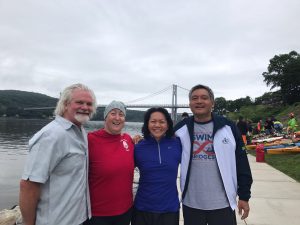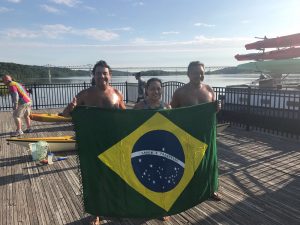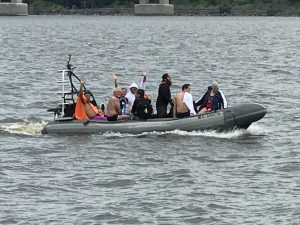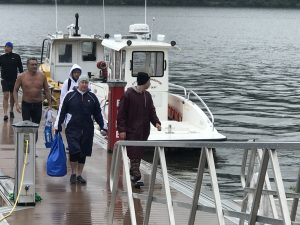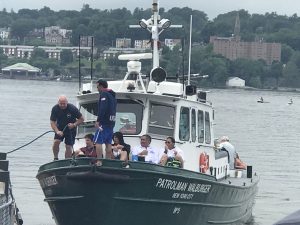By Liz Morrish
It was a poignant moment seeing Agent Orange, David Barra’s intrepid safety RHIB, tied up at the Washington Irving Boat Club. I was dreamily re-living the week’s swims from the comfort of an Amtrak train back to Albany. It traces the eastern bank of the Hudson, and this journey is the source of my fascination with the Hudson.
Here were the Palisades that we passed just two days ago. And here, in reverse order were all those stunning bridges. The train sped by the large fjord at the Tappan Zee, and on to Bear Mountain, a glorious bridge. I revisited sights along the way which had been made memorable by the commentary provided by Roy, Greg and Rondi on Launch 5.
My own recovery will feature a sad retreat– from writing about this intense experience each day, and from a wide group of people whose company I enjoyed throughout the week. I wondered how the swimmers would manage their physical and mental recovery, though. I knew that full withdrawal may be delayed in some cases, as several swimmers and kayakers were planning to volunteer for the 20 Bridges round Manhattan swim this coming weekend.
Abby Fairman’s recovery was delivered to her right off the boat by an unlikely waiter at La Marina – Ed Riley, his arm draped with a bar towel greeted her with a cold been on a platter.
Harry Finger was staying on for a few days in New York, hoping for a long-delayed massage. Flavio Toi was also looking forward to seeing more of New York and spending time with his son Tiago who swam under the Verrazano Narrows Bridge with him yesterday. His wife Estela would today embrace the prospect of dry land after a nauseous ride across the Battery in the observer boat yesterday. I laughed at the Facebook video of these three friends pretending to swim through Times Square.
During a rather difficult year, I have taken refuge in the prospect of joining the 8 Bridges volunteers, and it has been a huge privilege. I have been encouraged by all the positive comments about the blog from the swimmers, and on Twitter and Facebook. That kept me cranking out the pages each evening. I have shared an extraordinary week and learned not just about marathon swimming, but about determination, perseverance …. and punctuality.
I have appreciated:
The strength and consistency of Stephen Rouch. Focused and dominant, he was never beaten, but he loved a challenge.
The cheerfulness and good humor of Ed Riley, Graco Morlan, Steve Gruenwald and Abby Fairman.
The commitment and disciplined preparation of the Brazilian team. Marta and Flavio just kept getting faster. I will always be grateful for their kindness to me.
The resilience and self-belief of Harry Finger and Jamie Tout.
The persistence of Katrin Walter who struggled with the cold, but kept on turning up and nailed every single other day.
The expertise of the kayakers, and Captain Greg.
I will remember great conversations with Spencer Schneider, Roy Malinak, Devon Clifford, Jackie Boner Luis Lopez, Louise Hyder-Darlington, Pat Kerrigan, Janine Serrell, Greg Porteous and Rondi Davies.
And while I was asking about approaches to recovery after each marathon swim, Ed Riley chipped in, offering his own inimitable remedy. “I have sex”. Of course.

